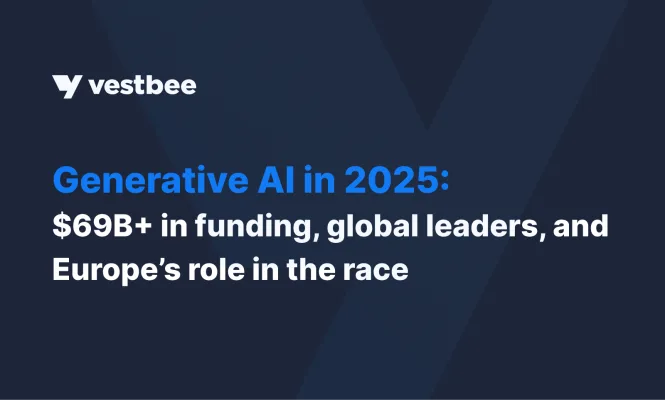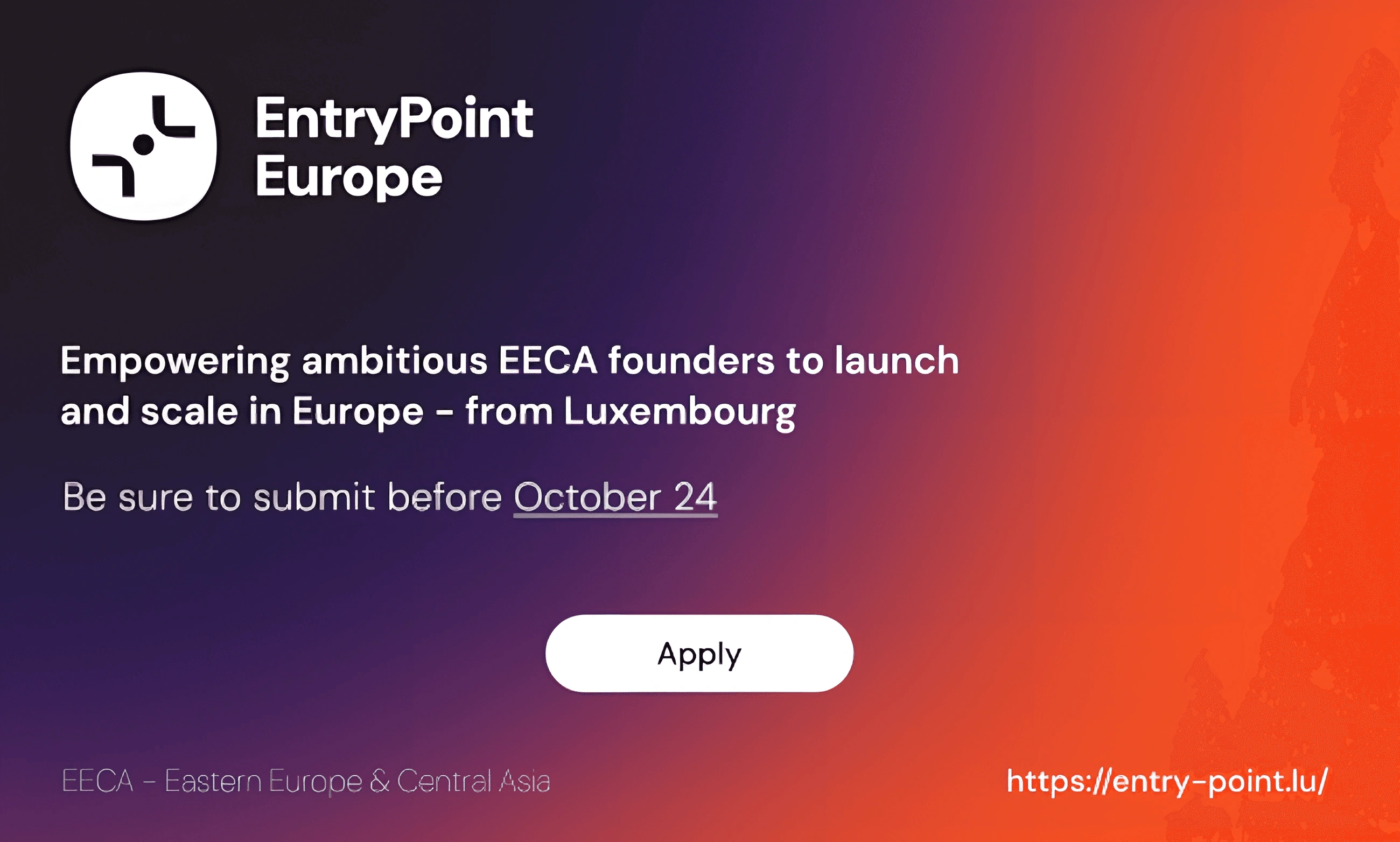While tech giants like OpenAI and Meta dominate the headlines, a new breed of companies is rising rapidly, building foundation models, AI infrastructure, and end-user applications that are reshaping traditional industries. Some directly challenge the dominance of Big Tech, while others quietly embed themselves deep within the AI value chain.
In 2025, Generative AI startups collectively raised over $69.6 billion, accounting for 11.77% of all venture capital deployed worldwide. Yet as capital pours in, the picture is far from uniform. The United States dominates foundation model development, but Europe is fast emerging as a serious contender — not by mimicking Silicon Valley’s playbook, but by leaning into its strengths: technical depth, regulatory foresight, and vertical specialization.
Vestbee unpacked the current state of GenAI venture capital landscape, mapping global investment trends, zooming in on Europe, and spotlighting the biggest funding rounds and most notable startups across three key segments of the AI stack: model makers, infrastructure, and applications.
GenAI in VC: globally
The AI investment boom is not cooling off. In 2024, Generative AI startups raised over $48 billion, a twentyfold increase from 2020. That’s nearly as much as all venture capital raised in Europe during the same year. And the momentum has only intensified: by mid-2025, AI companies globally had already secured $69.6 billion in funding, representing 11.77% of all VC deployed across sectors.
What began as a bet on foundation models has now matured into a full-stack investment opportunity. While over 50% of GenAI funding has gone to model makers, such as OpenAI, Anthropic, and Mistral, investor attention is increasingly turning to applications (19%), apps with proprietary models (17%), and the operation layer (9%), where defensibility and distribution are often easier to establish.
Applications. The second-largest funding category spans a wide range of verticals and media types — from chat-based assistants and internal copilots to tools for code, design, and 3D asset creation. Notably, text-based use cases still dominate, including copywriting, customer support, and enterprise knowledge systems. Applications typically fall into two camps: those building on proprietary models, and those leveraging third-party APIs.
Operations layer (Infra). As GenAI adoption scales, so does the need for purpose-built tooling. From prompt engineering frameworks and vector databases to MLops platforms, infrastructure has become a critical enabler. This includes players like Pinecone and Weaviate, who helped push vector DB funding to an all-time high of $210 million in 2023, and legacy MLops providers like Scale AI, now layering in GenAI functionality. Major cloud providers and Big Tech firms are also racing to build custom AI hardware to reduce dependency on NVIDIA and improve cost margins.
When it comes to round sizes, in 2024 GenAI companies consistently outpaced both broader AI and general tech peers — often by huge margins, showing a significant premium at every stage, from Seed to Series C+.
- At the seed stage, GenAI startups raised an average of $8.9 million, nearly double the average for traditional tech ventures and that of other AI startups ($4.8 million). The gap widened further at Series A, with GenAI rounds reaching $34 million — a full 70% above broader AI ($20 million).
- By Series B, GenAI’s dominance became even more pronounced: $199 million on average, nearly three times the broader AI benchmark and four times the rest of tech. Even at Series C and beyond, where deal sizes often plateau, GenAI companies raised an average of $213 million — nearly twice the amount other tech startups secured.
GenAI in VC: Europe
From 2019 to 2024, European GenAI startups raised a total of $6.1 billion, a fraction of the global total but still a significant signal of the continent’s growing momentum in the field.
In a landscape dominated by US and Chinese giants, Europe is positioning itself as a strategic AI contributor, particularly in open-source models, enterprise-grade applications, and ethical AI tooling. France has emerged as the regional frontrunner, producing all three of Europe’s notable frontier models in 2024 (Mistral, Kyutai, and LightOn). Compared to the US, European AI startups get smaller rounds, often aimed at technical depth, research spinouts, or B2B infrastructure plays.
There is also a more pronounced public-private synergy, with initiatives like France’s €500 million AI fund (via Bpifrance) or Germany’s AI startup ecosystem supported by federal R&D programs. Many of Europe’s GenAI startups are also leveraging open science ecosystems and university partnerships - for instance, Hugging Face (originally French) and Aleph Alpha (Germany) are both built on strong academic-research roots.
Beyond France, when it comes to geography, other emerging hubs of AI innovation include Germany (especially in mobility, robotics, and manufacturing), the UK (prominent synthetic data platforms and generative design tools) and the CEE region (a fast-rising source of technical talent and lean innovation, with increasing VC interest from pan-European and US funds).
Despite its growing momentum, Europe’s AI ecosystem still faces several structural troubles. According to Dealroom, scaling remains a persistent challenge, as many promising startups struggle to secure late-stage funding domestically and often turn to US or Asian investors to bridge the gap. Access to advanced compute infrastructure is another limiting factor — most European startups continue to rely on US-based cloud providers, which raises both cost and sovereignty concerns.
At the same time, the continent continues to experience a steady talent drain, with top researchers and engineers often lured by the scale, compensation, and opportunity of labs and startups in the US. These constraints don’t neccesarily undermine Europe’s position, but they do slow the continent’s ability to compete at the scale and speed set by global leaders.
Most notable global funding rounds in AI
- OpenAI remains the undisputed leader, pulling in a massive $40 billion round in early 2025, led by Microsoft, SoftBank, Founders Fund and Magnetar Capital, pushing its valuation to $300 billion.
- Elon Musk’s xAI raised $10 billion at an $80 billion valuation pre-raise, with backers including Morgan Stanley and other undisclosed institutional players. The company also closed two additional $6 billion rounds within a year — bringing its total to $22 billion — with support from investors such as Andreessen Horowitz, Sequoia Capital, and Qatar Investment Authority.
- Another standout is Scale AI, which raised a staggering $14.3 billion at a $29 billion valuation, backed by Meta, doubling down on its position as a leading data infrastructure provider for AI models.
- Similarly, Anthropic, the team behind Claude, continued its funding spree with a $3.5 billion injection that brought its valuation to $61.5 billion — thanks to Salesforce Ventures, Lightspeed and Alphabet— alongside a separate $4 billion commitment from Amazon as part of its broader strategic partnership.
- Notable infrastructure-focused players also drew attention: CoreWeave, an AI cloud compute startup, secured $1.1 billion at a $19 billion valuation, and Groq, known for its ultra-low latency AI chips, brought in $1.5 billion from the Kingdom of Saudi Arabia.
- Meanwhile, Lambda, a training-focused GPU cloud company, raised $480 million with participation from NVIDIA and ARK Invest.
The generative AI space wasn’t limited to American giants.
- Mistral AI and Aleph Alpha in Europe, as well as Moonshot AI in China, joined the unicorn club with billion-dollar rounds. Even in defence and embodied AI, the capital kept flowing.
- UK-based Wayve secured $1.1 billion from SoftBank, Microsoft and NVIDIA to further its self-driving tech, while US defense tech company Anduril Industries raised $1.5 billion to scale autonomous military systems.
- Perhaps most intriguing is the rise of AI-first biotech like Xaira Therapeutics, and experimental labs like Safe Superintelligence, both of which raised rounds in the $1–2 billion range, signaling VC appetite even for highly speculative moonshots.
In Europe, according to State of Tech 2024, other major rounds that year outside of Mistral AI reflected the growing diversity of the European AI scene:
- Helsing raised €450 million for defence AI.
- Poolside AI closed a €400 million round to scale its software engineering foundation models.
- DeepL brought in €300 million to advance its neural translation technology.
- Emerging players included Magic.dev ($117M), originally founded in Austria with ambitions for general-purpose AI in code generation, and CEE-founded and UK-based ElevenLabs, which raised $80 million for multilingual voice AI.







